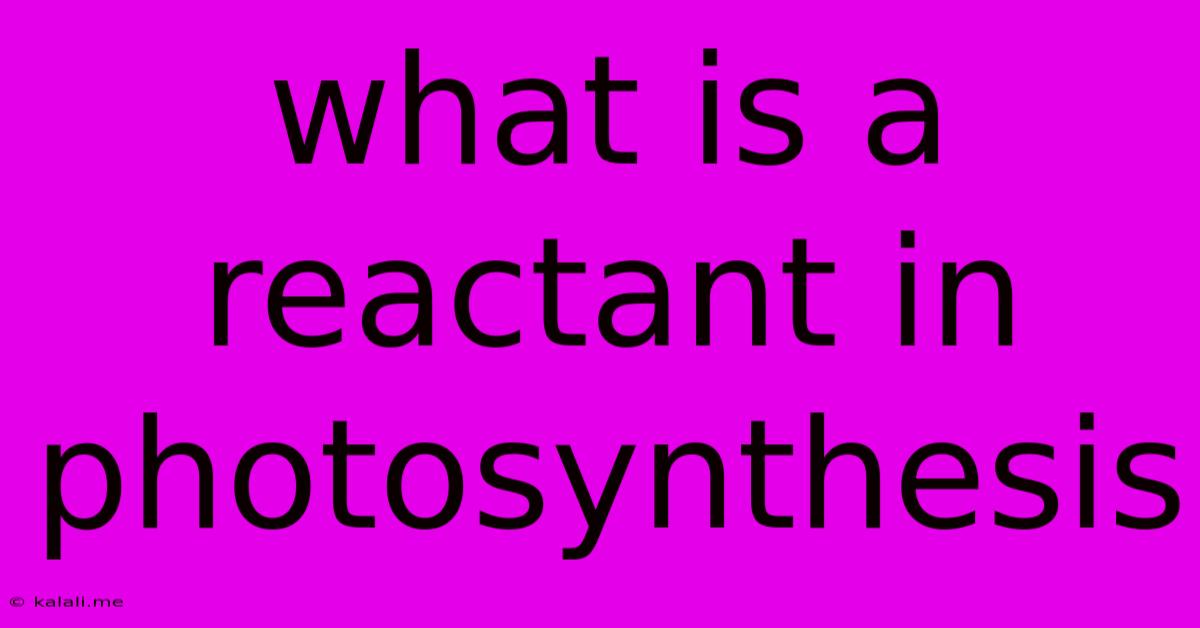What Is A Reactant In Photosynthesis
Kalali
May 09, 2025 · 3 min read

Table of Contents
What is a Reactant in Photosynthesis? Understanding the Ingredients of Plant Life
Photosynthesis, the remarkable process by which plants convert light energy into chemical energy, relies on specific ingredients known as reactants. Understanding these reactants is key to comprehending how plants sustain themselves and, by extension, support the entire food chain. This article will delve into the essential reactants of photosynthesis, explaining their roles and importance. We'll explore the process itself, clarifying the chemical reactions involved and the resulting products.
What are Reactants? In any chemical reaction, reactants are the substances that are consumed or used up during the process. The reactants in photosynthesis undergo a transformation, forming new substances called products. Think of it like a recipe: the reactants are the ingredients, and the products are the finished dish.
The Key Reactants: Carbon Dioxide and Water
Photosynthesis essentially combines two key reactants: carbon dioxide (CO2) and water (H2O). These seemingly simple molecules are the building blocks for the complex sugars plants produce.
-
Carbon Dioxide (CO2): Plants absorb carbon dioxide from the atmosphere through tiny pores on their leaves called stomata. The carbon atoms from CO2 are incorporated into glucose, the primary sugar produced during photosynthesis. This process is crucial for the plant's growth and development, as carbon is a fundamental component of all organic molecules. Without adequate CO2, photosynthesis slows down significantly. This is why atmospheric CO2 levels play a vital role in global plant productivity and, consequently, the planet's ecosystems.
-
Water (H2O): Water is absorbed by the plant's roots from the soil and transported throughout the plant via the xylem. In photosynthesis, water acts as both a reactant and a source of electrons. The electrons are essential for the electron transport chain, a crucial stage in the process where light energy is converted into chemical energy. Water also provides hydrogen ions (H+), which are incorporated into glucose molecules.
Light Energy: The Catalyst
While not technically a reactant in the same way as CO2 and H2O, light energy is absolutely essential for photosynthesis. It acts as a catalyst, providing the energy needed to drive the chemical reactions. Plants capture light energy using chlorophyll, a green pigment found in chloroplasts. This captured light energy powers the conversion of CO2 and H2O into glucose and oxygen. The wavelength and intensity of light significantly influence the rate of photosynthesis.
The Products of Photosynthesis: Glucose and Oxygen
The products of photosynthesis are glucose (C6H12O6), a simple sugar, and oxygen (O2). Glucose serves as the plant's primary source of energy and building material for other complex molecules like cellulose (for cell walls) and starch (for energy storage). Oxygen is released as a byproduct into the atmosphere, a vital component for the respiration of many organisms, including humans.
Understanding the Interplay of Reactants
The efficiency of photosynthesis is directly linked to the availability of the reactants: CO2 and H2O. Environmental factors such as temperature, light intensity, and water availability influence the rate of uptake of these reactants and, therefore, the overall rate of photosynthesis. Studying these factors is essential for understanding plant growth and productivity in various ecosystems. Furthermore, understanding the roles of CO2 and H2O allows us to appreciate the interconnectedness of life on Earth, highlighting the importance of maintaining a healthy atmosphere and water resources for supporting plant life.
In conclusion, the reactants in photosynthesis, namely carbon dioxide and water, are crucial for plant life. Along with light energy, they are the fundamental ingredients that drive this essential process, ultimately sustaining life on Earth. Understanding their roles allows for a deeper appreciation of the intricate mechanisms that power the planet's ecosystems.
Latest Posts
Latest Posts
-
How Many Acute Angles Are In A Acute Triangle
May 09, 2025
-
66 Is What Percent Of 120
May 09, 2025
-
Understanding Theoretical Actual And Percent Yield
May 09, 2025
-
What Is The Common Factor Of 15 And 25
May 09, 2025
-
How Much Is 1 75 Liters In Gallons
May 09, 2025
Related Post
Thank you for visiting our website which covers about What Is A Reactant In Photosynthesis . We hope the information provided has been useful to you. Feel free to contact us if you have any questions or need further assistance. See you next time and don't miss to bookmark.